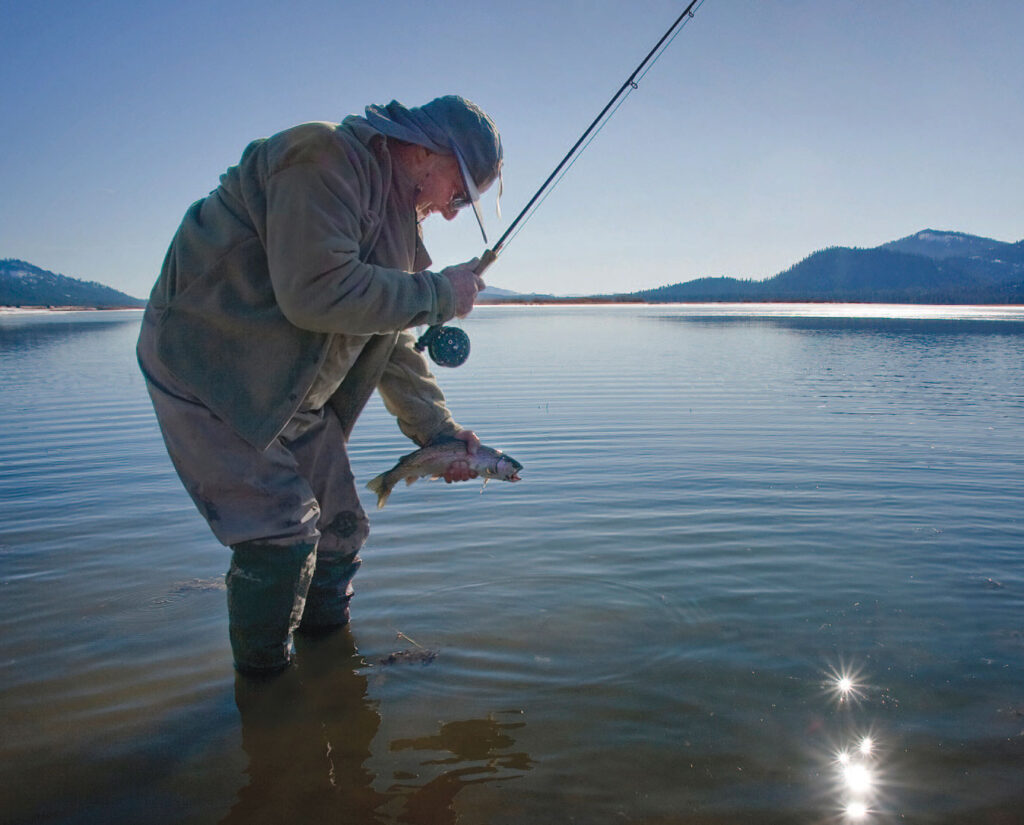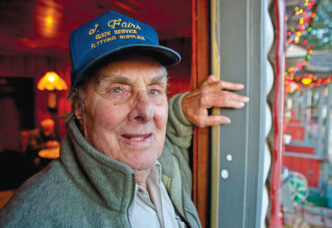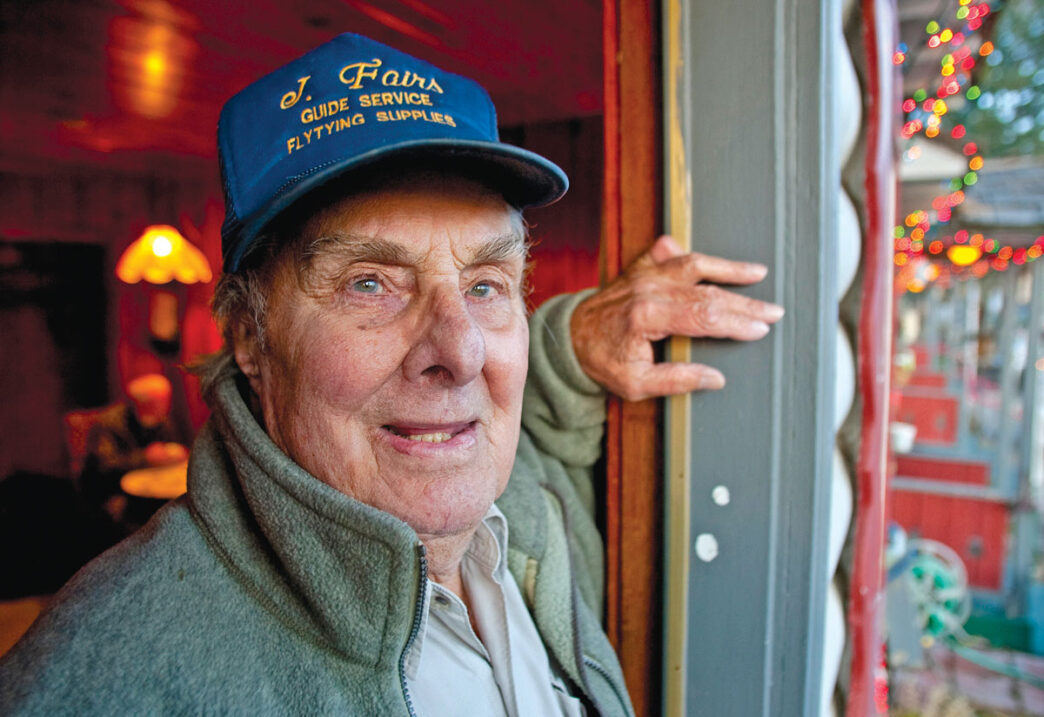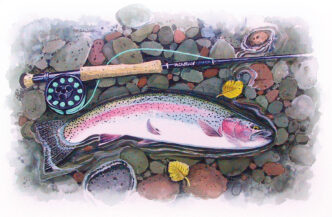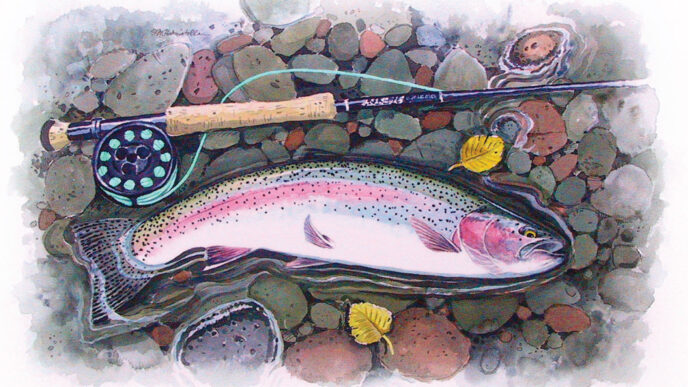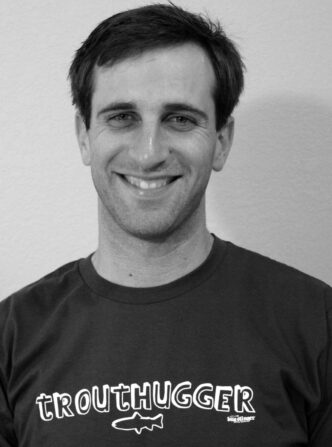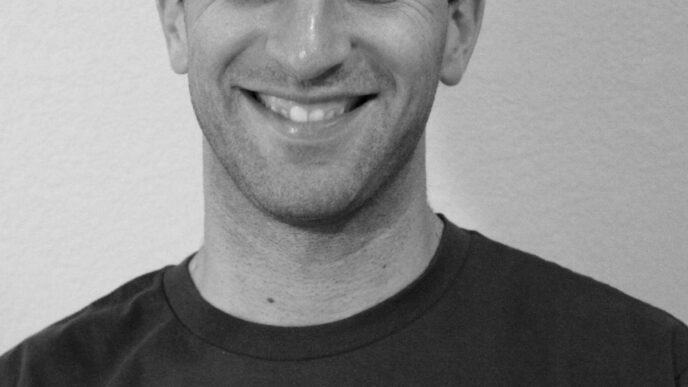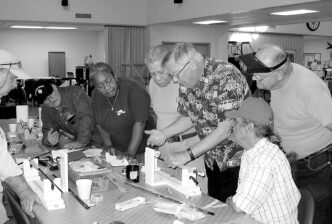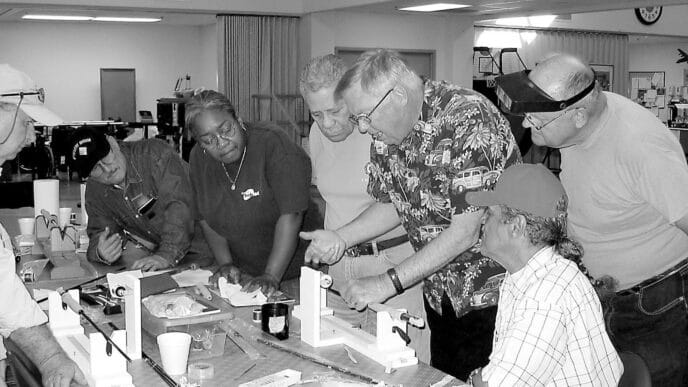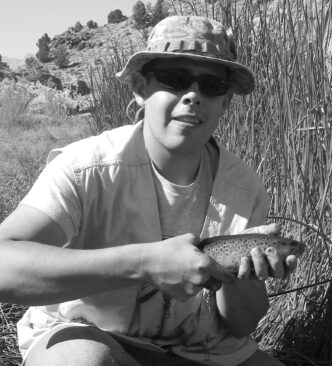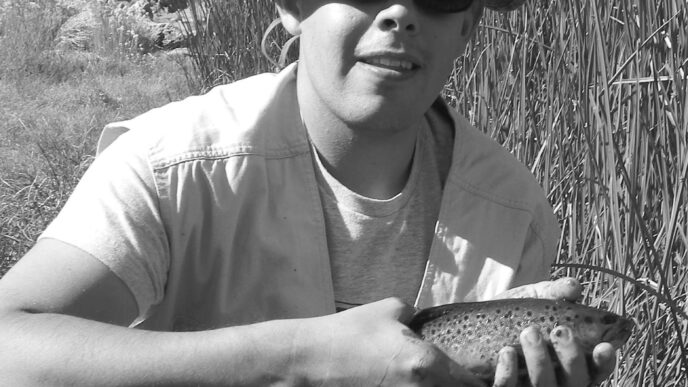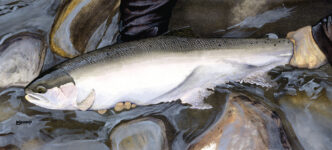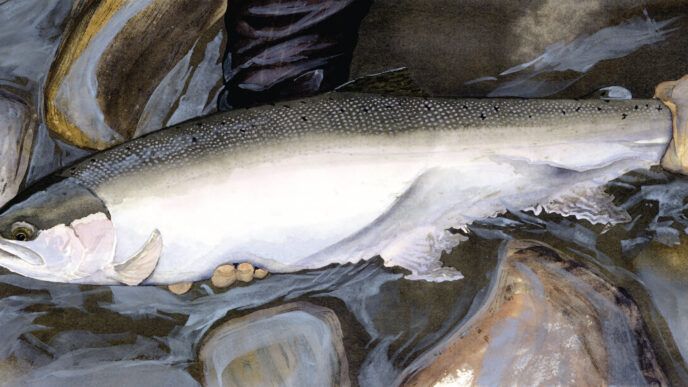Photographs by Rick E Martin
“You know, Bill,” Jay Fair proclaims in his slow, serious drawl, “fish sleep.” We’re sitting in his boat in shallow water at the upper end of Frenchman Lake. It’s one of those periods Jay calls “goof-off ” times, when fly rods are laid aside and observation or exploring is the primary occupation.
It’s also a time for storytelling, reminiscing, and all the other stuff that goes under the heading of BS-ing.
“Look,” Jay says, leaning over the side of the boat and slowly picking up his rod. Below us, in five or six feet of water, a rainbow that probably pushes 20 inches is lying motionless in the foliage of the lake bed. “That fish is asleep.” To prove his point, he reaches down slowly with the tip of his rod and strokes its back. The rainbow doesn’t move until Jay gives it a firm poke, and then it swims slowly off, like it hasn’t had its morning coffee yet.
Jay has been around a long time, 86 years now, and he’s fished most of those thirty-one thousand-plus days — not only fished, but observed, experimented, and studied fish and their habitat. Even today his motto is: “You gotta keep learning.”
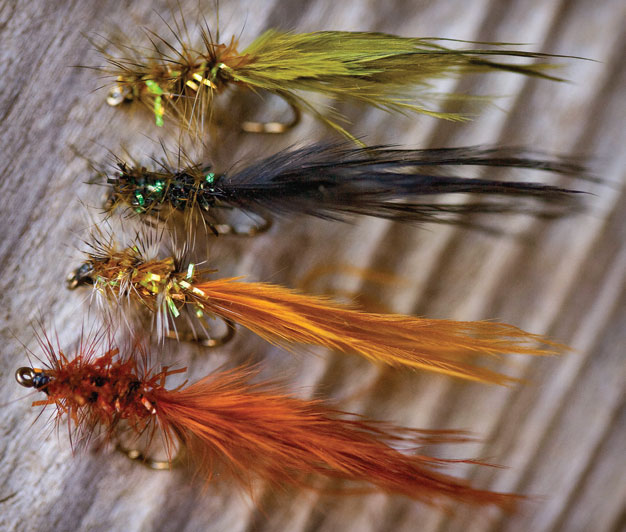
He guided for more than 35 years, and his name became synonymous with Eagle Lake. Where are the fish in this big Northern California lake? How do you catch them? Go with Jay Fair. And then there are his flies, not to mention his commercial line of flytying feathers that have killer colors not available from anyone else. Need a burnt orange or rust? Your local fly-fishing shop probably has it, but it carries the Jay Fair trademark.
Over the years, I’ve fished with Jay any number of times. “Fished” is perhaps the wrong word, because somehow we always end up turning it mostly into a “goof-off ” day, boating around a lake to check out spots or driving to some high-plains mountain reservoir he knows about and where he believes there might be big fish. Every time, I’ve learned something. Sometimes it’s a special spot on a popular lake, sometimes it’s an obscure one that has big fish, and sometime it is about how Jay, after long observation, believes trout behave.
From 1973 until two years ago, Jay guided an average of 140 days a year, usually on Eagle Lake or Lake Davis. Then two heart attacks, a new heart valve, and myriad other physical problems that seem to accumulate with age put him out of action. Let me emphasize that although he didn’t guide, he certainly didn’t stop fishing.
Now he’s ready for a comeback. This coming season, he and his son, Glenn, are reopening the guide service, along with a commercial specialty fly operation. (He sold the feather business, along with his formulas for the colors.) Glenn is a key to the whole thing. He learned at the hands of a master, and watching them together is fun. “Strip slower, Glenn,” says Jay. “Yes, Pop,” says Glenn. “Try that hole on your right,” says Jay. “Yes, Pop,” says Glenn. “Let it sink a little deeper,” says Jay. “Yes, Pop,” says Glenn. And so it goes.
Truth be told, Glenn is one hell of a fisherman, probably (dare I say it?) as good as his father. Better, if you consider that he is a fine caster and powerful wader. He’s fished all his life, and a few years back, when Jay began having physical difficulties, but was still guiding, Glenn sold his automotive business in Portola, near Lake Davis, and started helping his father on guide trips, a sort of two-for-one for clients.
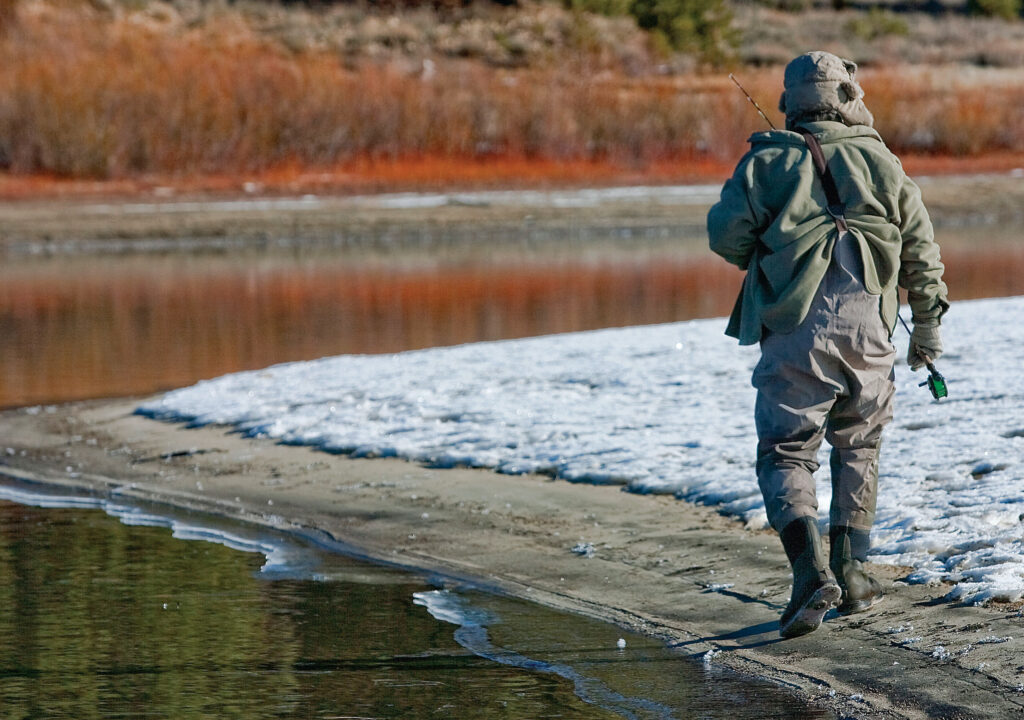
To top it off, Glenn is Jay, just 25 years younger. They talk alike, so much so that on the telephone, it’s impossible to know who you are talking to without asking. Now they intend to team up again, although Glenn is going to expand his horizons and also begin guiding alone on a regular basis. As for the flies, they’re calling that operation MustHave Specialty Flies. The patterns are basically the stillwater flies that Jay has designed over the years, such as the Jay Fair Special and his Wiggletail Nymphs. What has changed with the flies is that they now have longer marabou tails, which Jay says he’s found to be more effective.
Jay grew up on the land, earning a lifetime of experience on how things work in the great outdoors. He was just a kid when the Great Depression hit and his folks lost everything. They moved into a tent on a riverbank in northern New Mexico, where Jay trapped muskrats and skunks to supplement the family income. He quickly learned that fishing was his real calling and caught a daily limit (then 20 fish) and traded most of his catch to locals for home-grown produce for the family pot.
“I never got tired of fishing. I was a fishaholic. I never could understand why anybody would want to go to school when they could fish,” he says.
After World War II, when he moved to Southern California to find work, it was the same — every spare moment was spent fishing. He later settled in Northern California and turned to guiding full-time more than 35 years ago. Although he took clients on a number of lakes, Eagle Lake was his home turf, and Jay quickly became the guru of the second-largest natural lake in California, particularly for fly fishers.
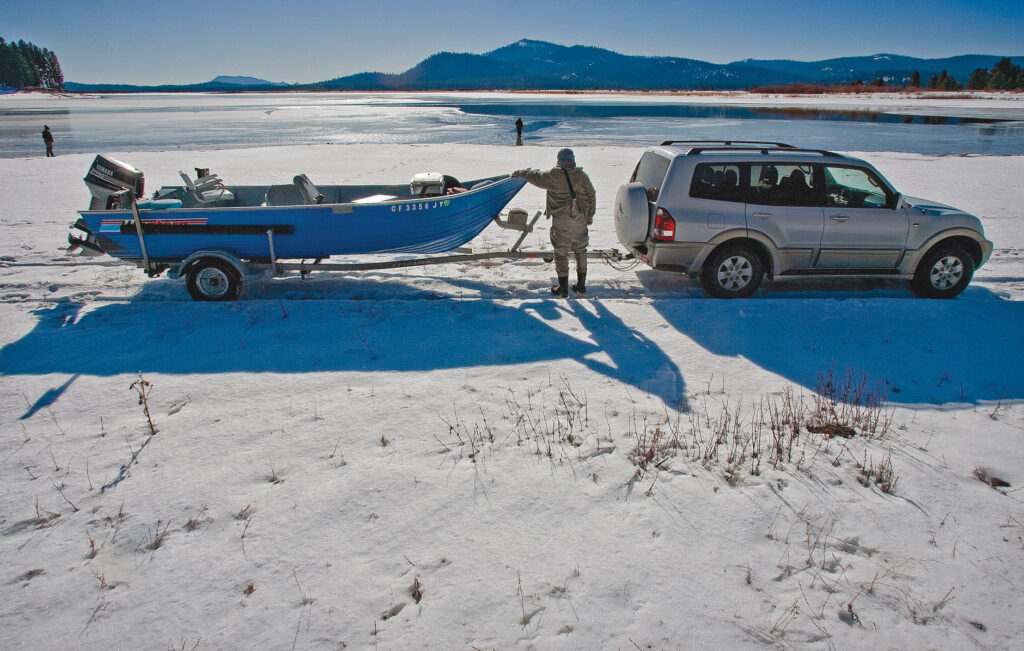
“It bothered me that when I took a client out fly fishing, they’d tell me their wife or kid was back in the motel because they didn’t know how to fly fish,” he says. “So I developed a fly we could use trolling; all they had to do was get it in the water, and they could hook fish. It was very effective.” The concept was successful enough for Jay to begin selling his trolling flies, not only to fly fishers, but to spin anglers, who found that they worked better than hardware.
The feather-dying business came about pretty much the same way. Jay saw a need for certain colors he felt were effective, but could not be bought commercially, so he experimented until he found the right combination. During the years Jay lived in Spaulding, a cluster of houses on Eagle Lake’s west shore, you didn’t need an address to find his home. You just looked for a residence where the clotheslines were draped with feathers that were drying.
Jay explains that it took a long time to find the right combination of dyes to get the exact colors he wanted, such as rust, burnt orange, and dark cinnamon. “What I try to find is a color that glows. First, we have to use an expensive European dye. And I always start with grizzly feathers. Then we experiment until we find that glow. That becomes the formula.”

Although the fly-tying-material business is no longer his, he’s comfortable with the product that still bears his name and believes his standards are being maintained by the current owner.
Jay says he’s always been a stillwater angler, “because that’s where the big fish are.” Now, fishing lakes and reservoirs from a boat has become a necessity for him, because he can’t walk far, and wading is difficult. In reality, that’s not much of a change — he’s almost always used a boat, if only to get to a section of a lake where he and his clients can get out and wade.
And since he has spent a lifetime seeking new waters to fish, he is a font of information on little-known lakes and reservoirs that hold big trout. Years ago, he put me onto the high-desert lakes in the Alturas area, mostly large cattle ponds that ranchers and farmers used to store their water: Nelson Corral, Buckhorn, and Dodge Reservoirs, along with Bayley and Round Corral Reservoirs. One of his favorites was McCoy Flat Reservoir, which sits alongside Highway 44 not far from Susanville. Alas, most of these have all but disappeared or no longer hold big fish, thanks to the drought years. Keep them in mind, though, because if California ever gets a few years of above-average moisture, they could regain their status as great big-trout fisheries.
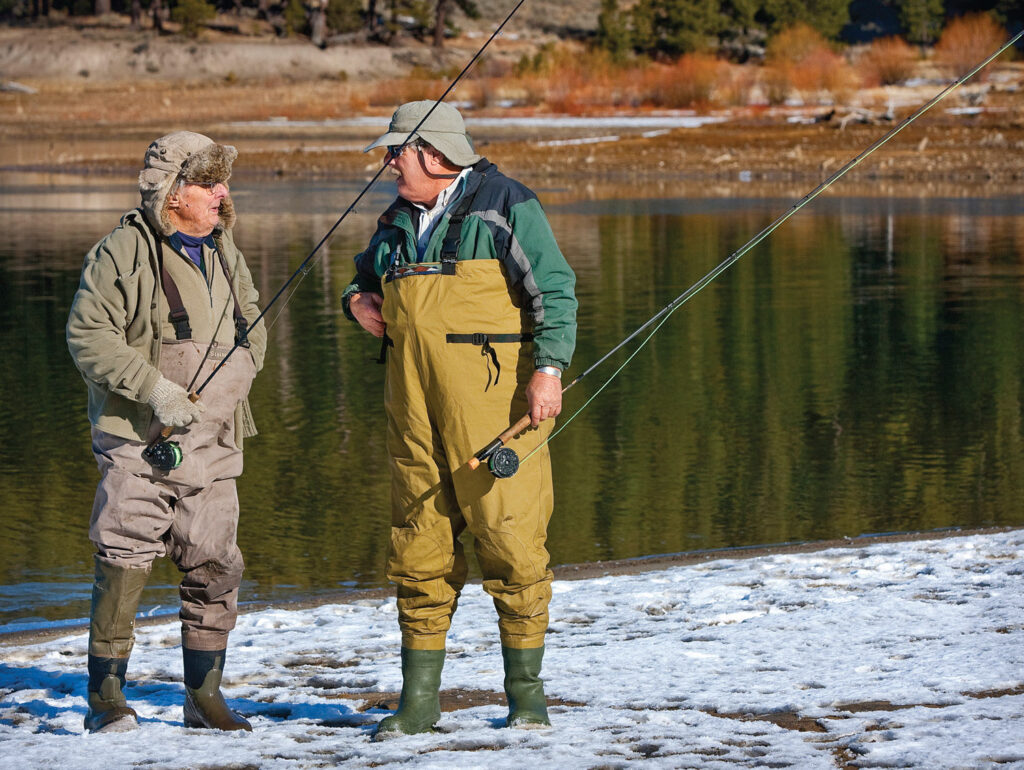
One Jay Fair favorite that still has big fish and not much pressure is Butt Valley Reservoir, only a few miles from Lake Almanor. It was a prime stillwater fishery until it was emptied in 1996 so the dam could be repaired. It has long since filled up again and is an excellent trout water, particularly at the upper end, where a PG&E powerhouse brings in water from Lake Almanor, along with a steady supply of food in the form of chopped-up minnows. It can be a big-fish bonanza when the powerhouse is operating.
When Jay and Glenn resume guiding this summer, they’re planning to add another dimension to the service — Klamath Lake. This shallow lake just across the border in Oregon is reputed to hold some big fish, but the lake itself is so huge that an angler needs to know where to go.
Save me a spot, Jay — this is one I’m looking forward to.
If you are interested in fishing with Jay or Glenn Fair or in buying their new line of flies, they can be reached at (530) 347-5811.
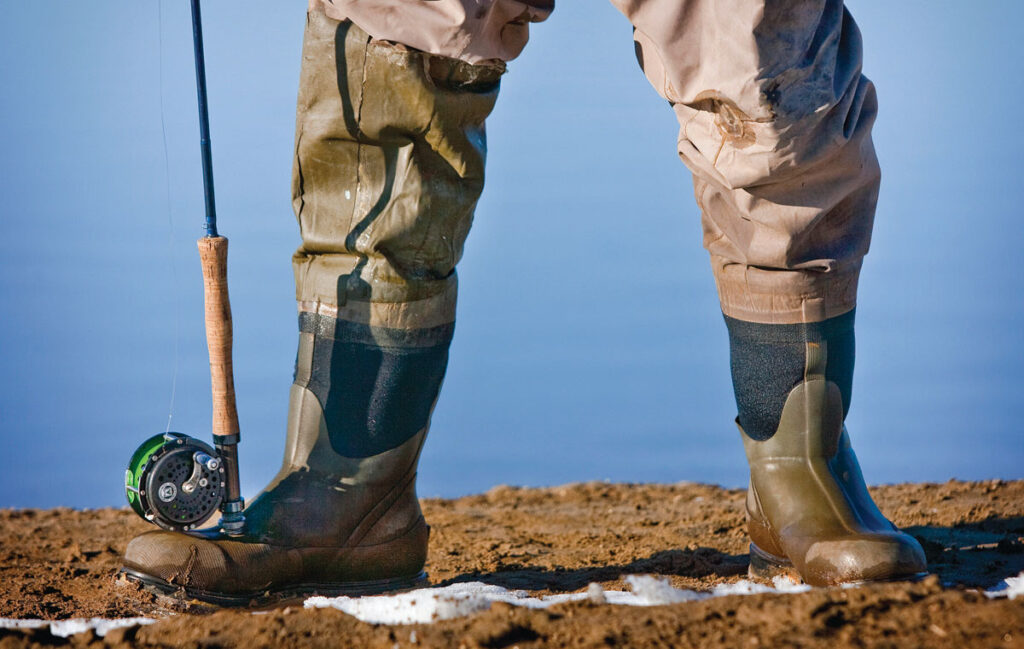
Jay Fair: His Own Words
“It takes energy to be a good fisherman. You have to love the outdoors, love what you are doing and where you are. You’re always looking for what’s around the next bend, what’s in the next hole. Fly fishing is a way of life.”
“In fishing, there is more anticipation of the strike than in the actual catching of the fish. You can’t wait to get that fish in so you can get another strike.”
“Some people say that in guiding, it is the overall experience, but really, fish are the bottom line. You get a guy who goes fishing only once or twice a year, and it’s important to him to catch fish.”
“In flies, fish like feathers because there is so much action, so much motion. It makes a fly more efficient if you mix colors. For example, start with a color, then put some white on top, hot-orange feathers on each side. Fish love mixed colors, because they really blend into one color in the water.”
“You hardly ever find a pod of really big fish. But smaller fish will fight over a fly. You’ll hook a fish and another will follow it, trying to take the fly away. Big fish instead defend their territory. At Eagle Lake, big fish in a tule patch will run other fish out.”
“People think fish are leader-shy. Let me tell you, you see that water with all that algae, all that junk floating around, and if you think that fish can pick that leader out of all that stuff, you’re just wrong. But if you think you can put a tiny fly on a six-pound leader, that’s wrong, too. You need to have a leader that matches the size of a fly.”
“I’ve never seen a short strike in my life. Now, fish come up and inhale your fly, come up and go slurp-slurp [in and out in quick succession] and then the fisherman strikes. It isn’t a short strike by the fish, but a late strike by the fisherman.”
“Fish go sound, sound, sound asleep. Feeding fish get so full something happens to them. It’s like they get a shot of Novocain. They just stop — they’re lying right there. A fish will get so much food I think it just shuts him down.”
